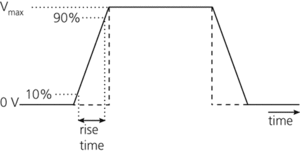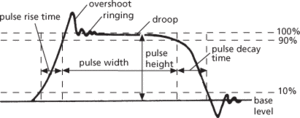1. A brief variation in a quantity, usually for a finite time, especially in a quantity that is normally constant.
2. A series of such variations having a regular waveform in which the variable quantity rises sharply from a base value to a maximum value and then falls back to the base value in a relatively short time.
A transient change in voltage, current, or some other normally constant physical parameter. This transient consists of a transition from one level to another, followed, after a fixed time, by an opposite and often equal amplitude transition. The first edge to occur on a pulse is the leading edge, the second transition being the trailing edge.
For rectangular pulses the transitions should in theory be stepwise, i.e. instantaneous. In reality however they require a finite time in which to occur. For transitions from low to high voltage, current, etc., a convenient measure of this time is the rise time, defined as the time required for the pulse amplitude to rise from 10% to 90% of its maximum value (see diagram). The fall time is the time interval between the 10% point and the 90% point on the negative-going edge of the pulse.
The time interval between the leading and trailing edge of a rectangular pulse is called the pulse width. The pulse height is the amplitude of a pulse, usually its maximum to minimum voltage, current, etc., ignoring any short-duration spikes or low-amplitude ripple superimposed on the main pulse. See also ringing

Pulse. Rectangular voltage pulse
.
A single transient disturbance, one of a series of transient disturbances recurring at regular intervals, or a short train of high-frequency waves as are used in echo sounding or radar. A pulse consists of a voltage or current that increases from zero (or a constant value) to a maximum and then decreases to zero (or the constant value), both in a comparatively short time. The zero or constant value is termed the base level. A pulse is described according to its geometric shape when the instantaneous value is plotted as a function of time: it can be rectangular, square, triangular, etc. Unless otherwise specified a pulse is assumed to be rectangular.
In practice a perfect shape is never achieved and a practical rectangular pulse is shown in the diagram. The portion of the pulse that first increases in amplitude is the leading edge. The time interval during which the leading edge increases between specified limits, usually between 10% and 90% of the pulse height, is termed the rise time. The pulse decays back to the base level with a finite decay time, usually taken between the same limits as the rise time. The major portion of the decay time is termed the trailing edge of the pulse.
The time interval between the end of the rise time and the start of the decay time is the pulse width. The magnitude of the pulse taken over the pulse width is normally substantially constant, and is the pulse height. The pulse height can be quoted either as the maximum value, the average value, or the root-mean-square value, all measured over the pulse width and ignoring any spikes or ripples. The height of a nonrectangular pulse, e.g. a triangular one, is normally the maximum amplitude.
A practical rectangular pulse can suffer from droop, which occurs when the pulse height falls slightly below the nominal value. The degree of droop is given by the pulse flatness deviation; this is the ratio of the difference between the maximum and minimum values of the pulse amplitude to the maximum amplitude, during the pulse width. A valley occurs when the droop exists only over a portion of the pulse width and the pulse height then recovers. The pulse crest factor is the ratio of the peak amplitude of the pulse to the root-mean-square amplitude.
A spike is an unwanted pulse of relatively short duration superimposed on the main pulse; ripple is unwanted small periodic variations in amplitude. A practical pulse frequently rises to a value above the pulse height and then decays to it with damped oscillations. These phenomena are known as overshoot and ringing. A similar effect occurs as the pulse decays to the base level. Pulse circuits may frequently incorporate a smearer, which is a circuit designed to minimize overshoot.
A group of regularly recurring pulses of similar characteristics is called a pulse train. The time interval between corresponding portions of the pulses in the train is the pulse spacing (or pulse-repetition period), T, and its reciprocal is the pulse-repetition frequency (or pulse rate), which is measured in hertz. Minor variations in the pulse spacing in a pulse train are known as pulse jitter. The duty factor of a pulse train is the ratio of the average pulse width to the average pulse spacing of pulses in the train.

Practical rectangular pulse
A series of waves of dilation that pass along the arteries, caused by pressure of blood pumped from the heart through contractions of the left ventricle. In humans it can be felt easily where arteries pass close to the skin surface, e.g. at the wrist.
- omnipresence
- omniscience
- omnivore
- omphacite
- OMR
- OMS
- OMS burn
- OMT
- OMVPE
- onager
- oncogene
- oncogenic
- oncoid
- oncolite
- oncolith
- oncotic pressure
- one
- one-address instruction
- one-circle reflecting goniometer
- one-dimensional flow
- one gene–one polypeptide hypothesis
- one-level store
- one over many principle
- one-pass program
- one-place predicate